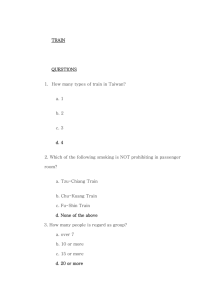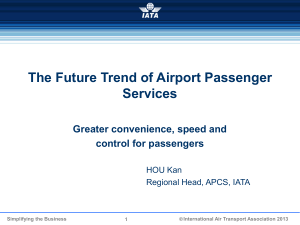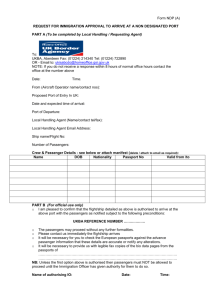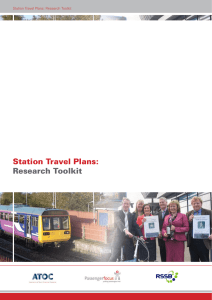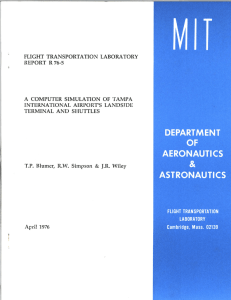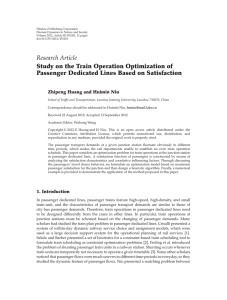QS 426/427/527/616 Aviation Security Quality Systems Project
advertisement
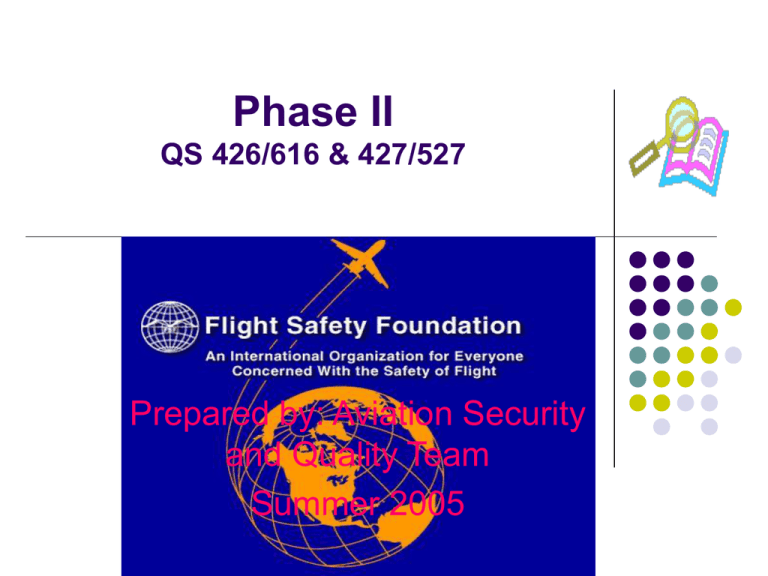
Phase II QS 426/616 & 427/527 Prepared by: Aviation Security and Quality Team Summer 2005 Project Background The attack on America by terrorist, using airplanes as tools of destructions, killing thousands on September 11, 2001, changed the way air travel is conducted forever. In the end, more than 3000 persons were killed in these four heinous attacks. I'm sure that each and every one of us has thought about what it must have been like for those passengers in their final moments on each of those four ill-fated airliners on September 11th, 2001.Thousands of innocent lives were lost because of fanatic martyrs who believe in some sort of a fantasyland after-life. Unlike hijackers of the past, there are no demands to be met or negotiations to be had. These people have only one motive; to kill as many Americans as possible and be willing to die for the cause; that is scary. Thanks to 9/11, and for the foreseeable future, passengers will board commercial airliners with a newfound type of anxiety. After all, our domestic security was breached and our air transportation system was violated. We can't help but wonder if the passenger sitting next to us has been properly screened and is not armed with a box cutter, knife, or other weapon with the explicit intent to harm Americans. Things are different today, that's for sure. Numerous security plans have been implemented since that time, to include limiting gate access to passengers, intense screenings, searches, and other security checks. However, whether these measures have really increased security is still questions. What we do know is that passengers have mixed levels of satisfaction with these new services used for aviation security. This project’s aim is to identify those measures of aviation security that users are satisfied with, unsatisfied with; specific problems and to suggest service improvements. Short Form Purposes / Content Team management review. Serve as an executive summary of long form – project focus. Project overview. Summarize findings, analyses, conclusions and recommendations – project. Team Management Review Combined two QS teams into one collective unit focused on the same industry and problems, each identifying different solutions; Course Rollout Matrix has been developed; New process methodology has been developed, implemented, and refined for the next tool; Communication structure enhanced and adhered to. Continuous Improvement Tracking Spreadsheet Combined QS Team Membership Structure Team is comprised of graduate and undergraduate students taking the QS 426/616 & 427/527 class. Members are: Derik Bailey, Justin Bayham, Walt Chrysler, Janett Gray, Shawn Meyers, Scott Roman, Troy Shrider, and Josh Seigley. Instructor/Advisor: Dr. John Sinn. Combined QS Team Membership Structure Combined QS Team: Aviation Security and Quality QS 426 / 616 Team Members Derick, Janett, Shawn Josh, Justin, Walter QS 427 / 527 Team Members Troy, Scott Josh, Justin, Walter Problem Statement Identify measures of aviation security that users find satisfactory, unsatisfactory, and/or problematic. In addition, suggest new services and technologies to raise customer satisfaction. Phase I on the project shall focus on identifying problems or unsatisfactory security measures. Phase II shall focus on identifying new services, technologies, and services to increase satisfaction, listing pro and cons of these services. Project Research Methodology Using each element of the ITTTM toolkit, which was studied and applied as a result of this course, the team used the materials to develop, organize, and document the project. This virtual team utilized communication tools such as the discussion boards and chats to communicate and track the project’s development, data gathering, and progress. New communication methods were instituted to develop the project in the amount of time for the remaining part of the course. Ownership of each was assigned to each member to be completed in whole with each team member there after commenting on the work and providing additional supportive documentation. Materials Five (5) Toolkits, per team, utilized: Tools 25-29 and 31-35 Phase I completed 25-27; 31-33 Phase II completed 28-29; 34-35 Materials 3 RCAs completed – PPARMP, ROLDA, PPMTA. 23 SDAs completed – OPCP, PASPC, ISOQSAOPP, GOTA, DSDC,TMPCAA, SAGE, OATCAF, SOPATA, OCA, GCA, GISPDCS, FMEA,SPSACA, GSICPC, LVAOACA, KCA, MAACE, APQPVC, APEIAR, QFD, CEAS. Project Descriptions The team’s project was the assessment of aviation security and quality: Identify measures that are satisfactory, unsatisfactory, and/or problematic; Suggest ideas to increase current efficiency and customer satisfaction; Suggest new services to raise customer satisfaction; Phase II - Propose new improved measures. Project Objectives 1. Identify current security and quality issues with respect to passenger checkpoints and propose improvements to increase effectiveness without compromising security levels; 2. Complete two (2) combined toolkit submissions assignments (toolkits 28 & 34; toolkits 29 & 35), assessing the applicable SDA’s from each tool; utilizing these tools in the stated project, as applicable; Project Objectives 3. Streamline RCA and SDA documentation to enhance overall effectiveness of the toolkit and project relationship; 4. Combine the two QS teams, 426/616 & 427/527, into one collective unit to create and manage one grand project working towards Phase II presentation; Project Objectives 5. Provide leadership and guidance to undergraduate students to further enhance the knowledge presented and obtained from the course. Project Passenger screening process For this project, the team focused on the passenger, as the customer. It was identified that although passengers wanted and expected increased security measures in airports, they were dissatisfied with the associated waiting time they had to endure as a result. The major cause of this wait time was due to the passenger screening process. Using wait time as the metric to improve, the team determined that the following measures would reduce wait/cycle time, therefore increasing customer satisfaction: Project Passenger screening process Passenger screening, as a measure of security, involves two primary methods: Walk-through metal detectors X-ray of carry-on baggage Long lines form, waiting to be screened Wait times average 30 minutes. Project Passenger screening process Using wait time as the metric to improve, the team focused specifically on methods to reduce wait/cycle time, therefore increasing customer satisfaction. Project results The team successfully identified several methods to reduce wait times. Utilizing the ITTTM courseware as the tool to manage the project, document and analyze results, the team successfully achieved the five (5) objectives listed, as follows. Project results Objective 1: Identify current security and quality issues with respect to passenger checkpoints and propose improvements to increase effectiveness without decreasing security levels. Achieved: Improvements proposed Eliminate, or dramatically reduce, the amount and size of carry-on baggage that is allowed. Example, one carry-on; includes purses. Dedicated security lanes - one for individuals without carry-on baggage; one with baggage but no laptop; one for laptops. Optimize screen staff utilization. Educate customers/passengers as to what is acceptable, what is checked, type of shoes, etc. Standardize process nationwide for all airports; consistency. Using these measures has a potential of reducing the average wait time from 30 minutes to only 10 minutes, 90% of the time. Project results Objective 2: Complete the five (5) toolkit assignments (Tools 25-29; Tools 31-35), assessing the applicable SDA’s from each tool; utilizing these tools in the stated project, as applicable. Achieved: Both of the original teams were successful in completing the five (5) toolkit assignments and associated assessments. However, this objective was exceeded when the two classes (426/616 & 427/527) were combined into the one team. This combination, fully implemented at the beginning of Phase II, exposed each member to tools from the other Project results Objective 3: Streamline RCA and SDA documentation to enhance the overall effectiveness of the toolkit and project relationship. Achieved: A new methodology was developed and implemented to streamline documentation and increase effectiveness. In the past, each team member completed every form and posted in Blackboard which was later compiled into one master document. With the new method, each member was assigned a specific document to complete and post, as the master document, in which the remaining team members reflected on the information provided, and add to it if deemed necessary. This methodology proved to work exceptionally well in that it minimized compilation time, reduced redundant submissions, standardized formatting, provided a cleaner form, and provided greater supportive information directed at the project objectives. Project results Objective 4: Combine both QS teams into one collective unit to create and manage (1) grand project working towards Phase II presentation. Achieved: As noted above, both teams were successfully combined at the start of Phase II. Project objectives were clearly defined with all members participating. The result of this combination created a synergic learning experience, providing more information and application of SDAs, to the team combined then separate. In addition, teamwork was greatly enhanced. Project results Objective 5: Provide leadership and guidance to undergraduate students to further enhance the knowledge taken from the course. Achieved: The three graduate students took the lead to direct, and assure, that toolkits were completed; objectives were focused, documentation correct/complete; and served as compilers for all submissions. Thereby, significantly improving the learning process.
